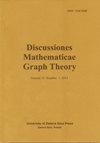图中全局双罗马统治数的界
IF 0.8
4区 数学
Q3 MATHEMATICS
引用次数: 0
摘要
摘要设G为n阶的简单图,设γgdR(G)为G的全局双罗马控制数。本文给出了G的全局双罗马控制数的一些上界,特别是完整地刻画了γgdR(G) = 2n−2和γgdR(G) = 2n−3的图G。我们的研究结果回答了Shao等人(2019)提出的一个问题。本文章由计算机程序翻译,如有差异,请以英文原文为准。
Bounds on the Global Double Roman Domination Number in Graphs
Abstract Let G be a simple graph of order n and let γgdR(G) be the global double Roman domination number of G. In this paper, we give some upper bounds on the global double Roman domination number of G. In particular, we completely characterize the graph G with γgdR(G) = 2n − 2 and γgdR(G) = 2n − 3. Our results answer a question posed by Shao et al. (2019).
求助全文
通过发布文献求助,成功后即可免费获取论文全文。
去求助
来源期刊

Discussiones Mathematicae Graph Theory
MATHEMATICS-
CiteScore
2.20
自引率
0.00%
发文量
22
审稿时长
53 weeks
期刊介绍:
The Discussiones Mathematicae Graph Theory publishes high-quality refereed original papers. Occasionally, very authoritative expository survey articles and notes of exceptional value can be published. The journal is mainly devoted to the following topics in Graph Theory: colourings, partitions (general colourings), hereditary properties, independence and domination, structures in graphs (sets, paths, cycles, etc.), local properties, products of graphs as well as graph algorithms related to these topics.
 求助内容:
求助内容: 应助结果提醒方式:
应助结果提醒方式:


